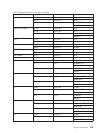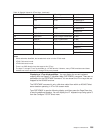The Telnet server must also be started. The interactive subsystem, QINTER, which
is used in previous examples in this chapter, needs to be started to run interactive
jobs for Telnet sessions. The spooling subsystem (QSPL) needs to be active to run
printer pass-through sessions.
Step 8—VTxxx—Creating User Profiles for Telnet Users
At the server system, create one or more user profiles for Telnet users from other
systems. The default user profile is *SYS. The following example shows a sample
user profile:
CRTUSRPRF USRPRF(CLERK1)
PASSWORD(unique-password)
JOBD(CLERKLIB/CLERKL1)
TEXT('User profile for Clerks Group 1')
Step 9—VTxxx—Checking the QKBDTYPE System Value
When the AS/400 Telnet server automatically creates virtual display devices, it uses
the QKBDTYPE system value to determine the keyboard type for the virtual device.
If the initial creation of the virtual device fails using the QKBDTYPE system value,
the Telnet server attempts to create the device again, using a keyboard type value
of USB. If the second attempt to create the keyboard type fails, then a message
(CPF87D7) is sent to the QTCPIP job log, indicating that the virtual device cannot
be automatically selected. This message is also sent to the system operator
message queue.
Step 10—VTxxx—Setting the Default Keyboard Mapping
When a Telnet session is negotiated in VTxxx full-screen mode, a default keyboard
map is used. To
display
the default keyboard map for VTxxx, use the Display VT
Keyboard Map command (DSPVTMAP) (see “Displaying a VTxxx Keyboard Map”
on page 205). To
change
the VTxxx keyboard map, use the Change VT Keyboard
Map (CHGVTMAP) command (see “Changing a VTxxx Keyboard Map” on
page 206) or the Set VT Keyboard Map (SETVTMAP) command (see “Setting a
VTxxx Keyboard Map” on page 206).
Because the VTxxx keyboard does not have the same keys as a 5250 keyboard, a
keyboard mapping must exist between the VTxxx keys and the AS/400 functions.
The AS/400 server assigns a default keyboard mapping when a VTxxx session is
first established. In some cases there can be more than one key or key sequence
that maps to a particular AS/400 function. In these cases, you can use any of the
defined keys to call the desired AS/400 function. Table 18 on page 202 shows the
5250 functions along with the default VTxxx key or key sequences that are mapped
to these functions.
Notes:
1. Each control character is a one-byte value that is generated from a VTxxx
keyboard by holding down the CTRL key while pressing one of the alphabetic
keys. Both shifted and unshifted control characters generate the same
hexadecimal values.
2. The escape sequences are multiple byte codes that are generated by pressing
the Esc key followed by the characters that make up the desired sequence.
3. The AS/400 server ignores the case of all alphabetic characters in an escape
sequence. You can type alphabetic characters in escape sequences in either
uppercase or lowercase.
Chapter 6. Telnet Server 201


















